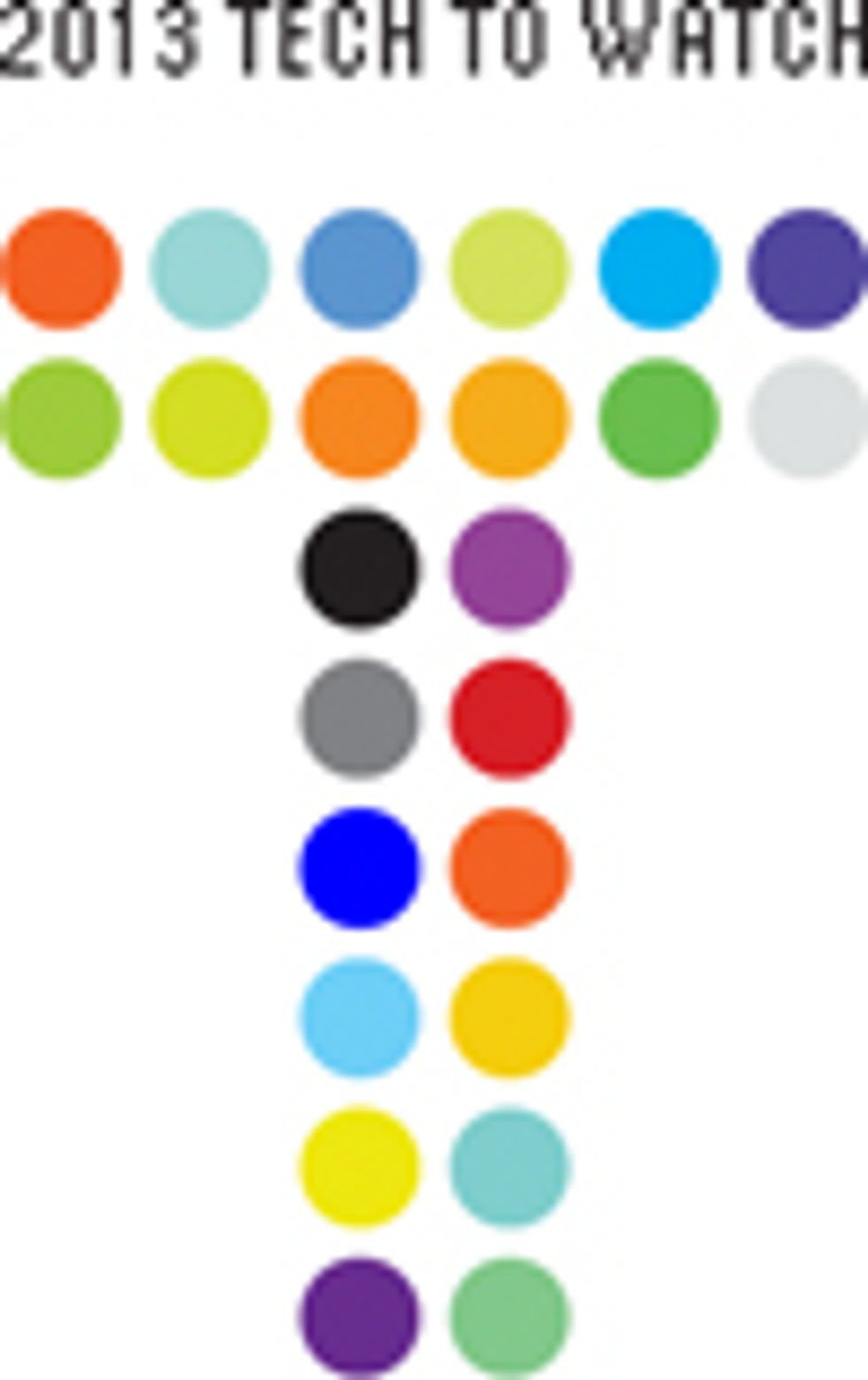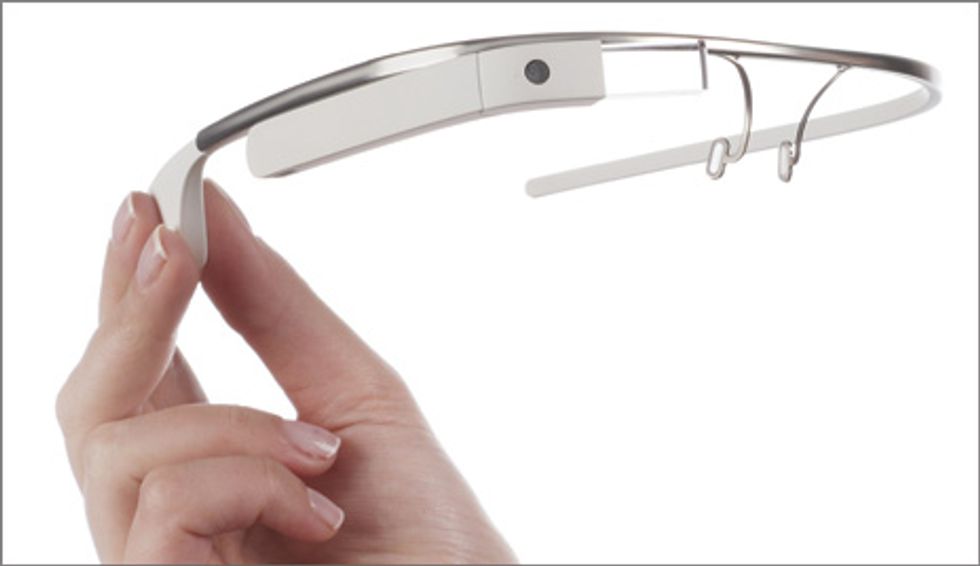Google Gets in Your Face
Google Glass offers a slightly augmented version of reality

For the past nine months,Google has been priming the public for the launch of Google Glass, a head-mounted, Internet-enabled display that—if you buy the hype—will revolutionize computing and totally rock your world.
A marketing blitz featured skydivers sporting Glass as they plummeted to Earth and runway models doing their best to strike a modish pose with the smart glasses perched on their noses. A YouTube video promoting the new specs tailed a man as he woke up, ate breakfast, went to a bookstore, met a friend, and shared a sunset with his girlfriend, all while receiving a stream of messages and augmented information about his surroundings on his Google Glass display.
In the next few months, Google will start shipping its smart spectacles to developers. More-polished consumer models are expected in 2014.
Is it worth the wait? Truth is, today’s Glass is more like a head-mounted smartphone than a true augmented reality appliance like the one featured in the YouTube video. It can’t superimpose tags, grids, maps, or running commentary on whatever you happen to be looking at. And despite the company’s attempt to associate Glass with high fashion, it still cries out nerdware. “Google—most of us use it every day,” observed comedian Jon Stewart. “But have you ever thought, ‘The real problem with Google is it’s too far from my face’?”
Details about Glass are still sketchy but here’s what we know. The lightweight browband, which looks like an ordinary pair of reading glasses minus the lenses, connects to an earpiece that has much the same electronics you’d find in an Android phone: a micro processor, a memory chip, a battery, a speaker, two microphones, a video camera, a Wi-Fi antenna, Bluetooth, an accelerometer, a gyroscope, and a compass. The microdisplay is positioned over one eye.
That hardware lets Glass record its wearer’s conversations and surroundings and store those recordings in the cloud; respond to voice commands, finger taps, and swipes on an earpiece that doubles as a touch pad; and automatically take pictures every 10 seconds. Prototypes connect to the Internet through Wi-Fi or through Bluetooth and a smartphone. Future versions will likely include a cellular antenna.
The company says Glass will be small enough, light enough, and stylish enough to wear all day, like a favorite fleece or a comfy pair of sneakers. Glass will run apps like Google+ and Google Search, but it’s designed to feel more natural and immersive than a PC or a smartphone. Ideally, Babak Parviz, the leader of Project Glass, told developers at the company’s Google I/O conference in June, it will let you access information “so fast that you feel you know it.” [Parviz elaborates on Google's plans for Glass in this Q&A.]
That’s right: Google says that Glass will make you feel smarter. “We’re talking about a device that sees every thing you see and hears everything you hear,” says Rod Furlan, an artificial intelligence researcher and angel investor. “From the starting line what you are gaining is total recall.”
To become more than a niche product, though, Glass must clear a few hurdles.
First, there’s the competition. “If Google Glass gets commercial traction, everybody and their brother will start building similar displays and interfaces,” predicts Alex “Sandy” Pentland, director of MIT’s Human Dynamics Laboratory.
That’s already happening. Start-ups Atheer, First Person Vision, Lumus, and Vergence Labs all have Glass-like prototypes in the works. Specialty manufacturer Recon Instruments makes MOD Live, a head-up display for skiers that analyzes their jumps. Established firms like Apple, Microsoft, Olympus, and Sony have been conducting research into smart glasses and head-up displays for years.
All that activity may finally add up to a robust market for smart glasses, says Theo Ahadome, a senior analyst at British market research firm IMS. If Google Glass is embraced by early adopters, Ahadome thinks the market could grow from less than US $1 million today to $700 million by 2016. If the products then spread to mainstream consumers, that figure could jump to several billion, he says.
Already, Glass seems to have thrown a lifeline to an industry that has struggled for decades. In May, shortly before Glass was unveiled, Vuzix Corp., a 20-year-old company that makes augmented-reality eyewear, stated in a filing with the U.S. Securities and Exchange Commission that “doubt exists about our ability to continue as a going concern.”
Since Google’s announcement, however, Vuzix has renegotiated loan agreements, signed a development contract with the U.S. Army, and announced a Glass-like version of its eyewear to be released in early 2013. Built on the Android 4.0 operating system, Vuzix Smart Glasses M100 won a Best of Innovations award [PDF] at this year’s International Computer Electronics Show, in Las Vegas. “Google is getting people to think about all the new experiences they can have using see-through displays and sensors,” says Paul Travers, CEO and founder of Vuzix.
But even Google will have to convince people that wearing a computer on their faces all day is something they want to do, a hard sell even to technophiles. “I’m not hugely interested in Google Glass because, although I’m very keen on augmented reality, that’s not what Google Glasses are,” science-fiction writer Bruce Sterling wrote in an e-mail to IEEE Spectrum. “Google Glasses are more like a head-mounted Android unit, and there’s not much in the way of live inter action with 3-D virtual images.”
Steve Mann, a professor at the University of Toronto who pioneered the development of Glass-like devices in the 1980s, says Google appears to be making some of the same design mistakes he made with his early proto types. Specifically, he says, positioning a micro display outside a person’s natural field of view could lead to eyestrain and visual confusion. “It doesn’t make you smarter. It makes you dizzier and more confused,” he says, adding that the display should be directly in front of the eye, like a product he developed called EyeTap. [Mann has more to say about his 30 years of research on smart glasses in this Q&A.]
Even if Mann’s worries prove unfounded, Glass’s battery life and processing heft will be a big issue; any application involving computer vision and streaming video will likely be a power and computing hog. Right now, the batteries reportedly last just 6 hours. Some developers are also grumbling about the $1500 price tag for the early prototypes. Presumably, the consumer version will be cheaper.
Let’s assume, though, that Google does win over millions of people. What then? Privacy advocates warn that Glass, and similar devices, could lead to an unprecedented loss of control over your personal information.
“The question is, what will Google do with the information they are collecting?” says Rebecca Jeschke, a spokeswoman for the Electronic Frontier Foundation, a leading privacy rights group. The company hasn’t revealed any Glass-related privacy policy, but the fact that the data exists in the cloud puts it within the reach of third parties. Current U.S. statutes allow law enforcement access to e-mail and cellphone records under certain circumstances without a search warrant. Governments in Australia, Canada, and the United Kingdom are seeking to expand their electronic monitoring powers.
MIT’s Pentland counters that the risk to privacy can be reduced if companies like Google provide people with full control of their own data. Making sure people know when they are being recorded will also help. And, he adds, governments are already pressuring corporations to adopt more privacy-friendly practices. The Consumer Privacy Bill of Rights, announced by the White House last February, and a joint declaration on protecting personal data signed last March by the United States and the European Union are evidence that the world is moving in the right direction, he says.
Others view the hand-wringing over privacy as passé. “We will soon be living in a hypervisible society, and there is nothing we can do to stop it,” argues Furlan, the artificial intelligence researcher. “It’s not about fighting the future; it’s about learning to live with it.”
Furlan was so eager to see what a future with Glass might look like that last summer he built his own prototype from off-the-shelf parts [see “Build Your Own Google” to learn how he did it.]. It streams e-mail, Twitter updates, text messages, and the status of his servers to a monocular microdisplay. At first, he says, the flood of information felt overwhelming, but now when he takes off the gadget, he feels “impoverished.”
He can’t wait to try the real Glass. Furlan believes Google’s expertise in data and in machine learning will lead to all kinds of applications that enhance people’s everyday experience. Yes, he says, you’ll have to give up some privacy, but the trade-off will be worth it. “In the end, I believe technology gives more than it takes,” Furlan says.
This article was modified on 3 January 2012.
About the Author
An editor for the cloud communications company Twilio, Elise Ackerman started covering the company in 2006, the same year she had Lasik eye surgery. Could Google Glass convince her to wear glasses again? “The enthusiasm of proponents is contagious,” Ackerman says. “But to go back to glasses, I’m going to need a killer app.”

